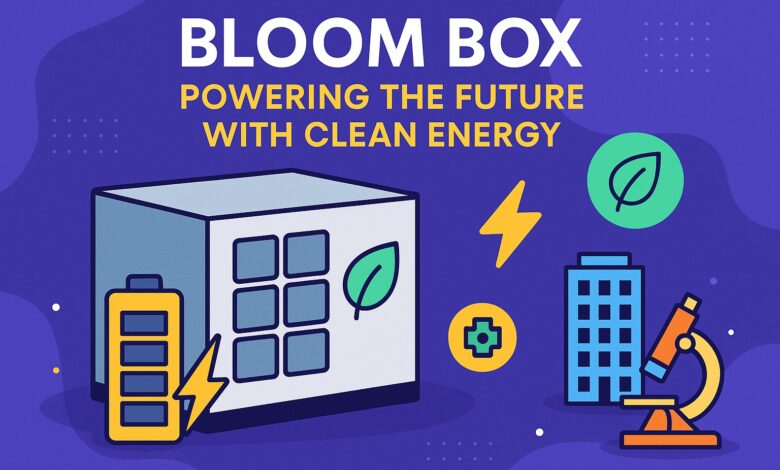Bloom Box: Revolutionizing Clean Energy with Next-Gen Fuel Cell Technology
How the Bloom Energy Server is transforming on-site power generation and sustainable solutions

Introduction to the Bloom Box
The Bloom Box is a revolutionary fuel cell system that has redefined how energy can be generated cleanly, locally, and efficiently. Developed by Bloom Energy, this innovation—officially called the Bloom Energy Server—uses solid oxide fuel cell (SOFC) technology to convert various fuels into electricity without combustion.
Invented by Dr. K. R. Sridhar, a former NASA scientist, the Bloom Box was originally conceptualized for extraterrestrial applications. Today, it’s a leading example of clean energy technology here on Earth, enabling on-site power generation for large enterprises and reducing dependence on traditional grids.
Quick Fact
| Feature | Description |
|---|---|
| Inventor | Dr. K. R. Sridhar |
| Company | Bloom Energy |
| Core Technology | Solid Oxide Fuel Cell (SOFC) |
| Fuel Types | Natural gas, biogas, hydrogen, landfill gas |
| Efficiency Range | 50% – 65% |
| First Public Reveal | 2010 |
| Typical Use Case | On-site, clean energy for enterprises |
| Notable Clients | Google, eBay, Walmart, FedEx |
The Bloom Box consists of multiple thin ceramic electrolyte plates coated with anode ink and cathode ink, each functioning as a mini power generator. These plates are made from materials like yttria-stabilized zirconia (YSZ) or scandia-stabilized zirconia (ScSZ), which allow oxygen ions to flow at high temperatures.
When a fuel source—such as natural gas, biogas, or hydrogen—is introduced, it reacts electrochemically with oxygen, producing electricity, water, and small amounts of CO₂. Because there’s no combustion involved, the process is cleaner and more efficient. Units are modular, meaning many fuel cell stacks can be combined into an entire modular power system, generating scalable outputs from 100 kW to megawatts.
Key Innovations Behind Bloom Box Technology
Solid Oxide Fuel Cells (SOFC)
Unlike conventional combustion-based generators, SOFCs operate at high temperatures—typically around 800°C to 1000°C. This thermal environment enhances energy conversion efficiency and reduces emissions significantly.
The Bloom Energy Server achieves efficiency levels between 50% to 65%, outperforming most grid-supplied energy and allowing users to benefit from low-carbon electricity while reducing their environmental impact.
Material and Design Excellence
Using ceramic electrolyte technology, particularly YSZ and ScSZ, offers excellent conductivity and durability. Bloom Energy’s proprietary designs ensure long-lasting stacks, although over time cell degradation may require fuel cell replacement. Despite this, ongoing Bloom maintenance services extend operational life.
Commercial Adoption and Use Cases
High-Profile Clients and Projects
Companies such as Google, eBay, Walmart, and FedEx were among the earliest adopters of the Bloom Energy Server. For instance, Google’s first test unit in 2008 provided power to part of its headquarters. eBay followed by installing multiple units, boasting annual savings in the six-figure range.
Distributed Generation in Practice
One of the Bloom Box’s strengths lies in distributed generation—producing power where it’s consumed. This reduces transmission losses and enhances reliability. The ES-5000 model, for example, can power large facilities with continuous, clean energy tailored to their demand.
Economic Considerations and Incentives
Cost per Watt and Efficiency
Initially priced at around $7–8 per watt, the Bloom Box cost per watt has declined over the years. With the help of government programs like California’s Self-Generation Incentive Program (SGIP), companies have achieved lower total cost of ownership and shorter payback periods.
Long-Term Savings
Operating costs with the Bloom Energy Server can be as low as $0.08 per kWh electricity, making it attractive compared to traditional grid power. Combined with reliability and independence from grid fluctuations, it presents a solid value proposition for enterprise energy solutions.
Environmental Impact and Sustainability
Reduced Carbon Emissions
Even when running on natural gas, the Bloom Box emits less CO2 per MWh compared to coal or oil-based systems. With biogas fuel cells or landfill gas energy, carbon neutrality is nearly achievable, making it a true alternative energy solution.
Clean Tech and the Green Future
As a notable clean tech startup, Bloom Energy has driven major strides in green energy innovation. Its sustainable power solutions support corporate ESG goals while also aligning with global net-zero targets.
The Road Ahead for Bloom Energy
IPO and Market Position
In 2018, Bloom Energy went public in a highly anticipated Bloom IPO. Since then, it has maintained a strong position in the clean energy technology market, despite competition from solar and battery storage industries.
Challenges and Opportunities
While the Bloom Box offers numerous advantages, challenges such as high-temperature fuel cell durability and dependency on fossil fuel infrastructure persist. However, ongoing research and upgrades offer promise for broader, global applications.
Frequently Asked Questions (FAQ)
What is a Bloom Box used for?
A Bloom Box generates on-site electricity using solid oxide fuel cell technology, ideal for powering data centers, hospitals, and corporate buildings with clean and reliable energy.
What fuels can a Bloom Box use?
It can run on natural gas, biogas, hydrogen, and landfill gas, offering flexibility and reduced environmental impact depending on the fuel source.
How efficient is a Bloom Box?
The Bloom Energy Server achieves 50% to 65% efficiency, higher than traditional fossil fuel plants.
Who invented the Bloom Box?
It was invented by Dr. K. R. Sridhar, based on earlier NASA research for Mars missions.
What are the maintenance requirements?
While durable, Bloom Boxes require periodic maintenance and fuel cell replacement every 5–10 years due to high operating temperatures.
Conclusion
The Bloom Box represents a milestone in the journey toward a cleaner, more efficient energy future. From its NASA research roots to commercial installations with global giants like Google and eBay, this solid oxide fuel cell technology showcases how science can be applied to solve real-world challenges. With its modular nature, fuel flexibility, and environmental advantages, the Bloom Energy Server is truly a power plant in a box—poised to lead the way in energy disruption and sustainable power solutions for decades to come.



